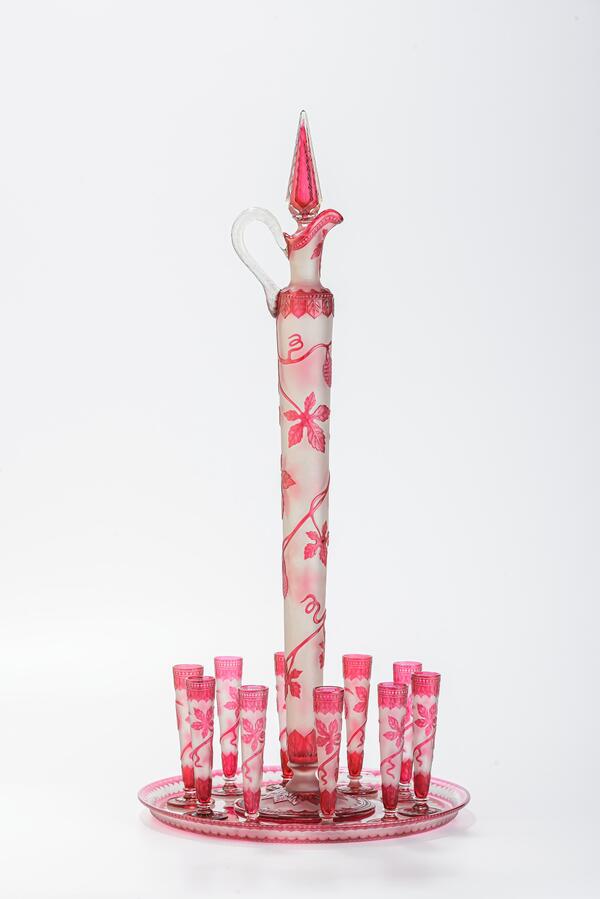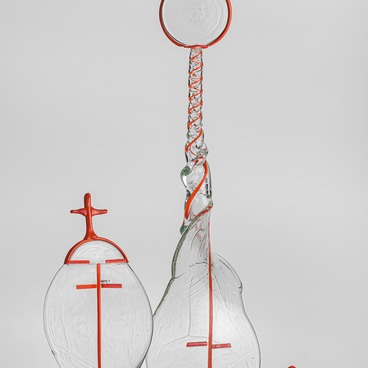It took a long time for the drinking culture to develop into a coherent and complex system. High society that was the main customer of the Nikolsko-Bakhmetevsky factory strictly followed these drinking traditions — only particular vessels were used for each type of drink.
A typical liqueur decanter set consisted of a jug, a tray, and at least four liqueur glasses — up to 100 milliliters each. These glasses were usually narrow and straight.
This is exactly the case with the presented set. The decanter with an elongated spout is crowned with a spike-shaped stopper, and ten elongated cone-shaped glasses rest on a round base. The body is decorated with a painted “gold ruby” pattern — a vine wrapped around the vessel. The base, the top, and the bottom of the decanter, as well as the middle of the tray are adorned with stylized leaves. The vine and leaves create a complete composition.
In 1900, more than 60 countries took part in a regular international exhibition in Paris. With this in mind, the glass blowers created a number of artworks: glasses, a beer set and two liqueur decanter sets. The items were made of colorless and frosted two-color glass.
The professional glassmaker Nikanor Ivanovich Protasov, the great-grandson of the first of the famous Bakhmetev artisans Alexander Vershinin, designed the decorative patterns and the shape of these sets.
The glassware that was demonstrated at the Paris exhibition received the Grand Prix and the Large Gold Medal. Moreover, the jury decided to award the glassmakers with personal bronze medals. The museum houses Nikanor Protasov’s medal which is decorated with an engraving that features the date “1900” and a man with a torch riding the winged figure of Glory. At the bottom is a city silhouette and a signature “n. protassoff”.
Nikanor Ivanovich Protasov devoted 62 years to production and was considered one of the best glassmakers in the country. In 1914, when the factory celebrated its anniversary, he received the personal title of honorary citizen, and in 1919, he became the first director of the Red Giant factory.
A typical liqueur decanter set consisted of a jug, a tray, and at least four liqueur glasses — up to 100 milliliters each. These glasses were usually narrow and straight.
This is exactly the case with the presented set. The decanter with an elongated spout is crowned with a spike-shaped stopper, and ten elongated cone-shaped glasses rest on a round base. The body is decorated with a painted “gold ruby” pattern — a vine wrapped around the vessel. The base, the top, and the bottom of the decanter, as well as the middle of the tray are adorned with stylized leaves. The vine and leaves create a complete composition.
In 1900, more than 60 countries took part in a regular international exhibition in Paris. With this in mind, the glass blowers created a number of artworks: glasses, a beer set and two liqueur decanter sets. The items were made of colorless and frosted two-color glass.
The professional glassmaker Nikanor Ivanovich Protasov, the great-grandson of the first of the famous Bakhmetev artisans Alexander Vershinin, designed the decorative patterns and the shape of these sets.
The glassware that was demonstrated at the Paris exhibition received the Grand Prix and the Large Gold Medal. Moreover, the jury decided to award the glassmakers with personal bronze medals. The museum houses Nikanor Protasov’s medal which is decorated with an engraving that features the date “1900” and a man with a torch riding the winged figure of Glory. At the bottom is a city silhouette and a signature “n. protassoff”.
Nikanor Ivanovich Protasov devoted 62 years to production and was considered one of the best glassmakers in the country. In 1914, when the factory celebrated its anniversary, he received the personal title of honorary citizen, and in 1919, he became the first director of the Red Giant factory.





